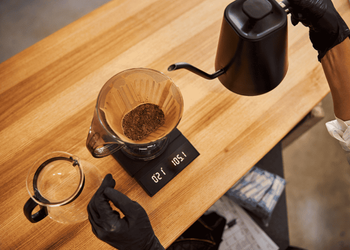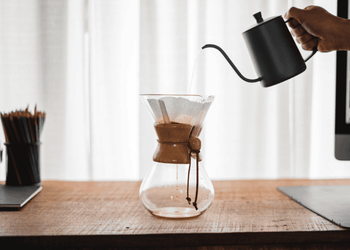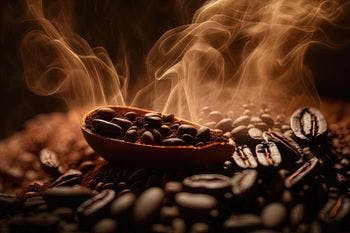
White vs Brown Coffee Filters: Which is Better For You?

Have you ever visited a grocery store and got confused between the white and brown coffee filters? Then you are not alone. Even I have been through it.
I always got confused when I was asked about which coffee filter I wanted.
Until I learned more about them. So to help you make the right choice, I am here.
Today, in this article, I will tell you the difference between white and brown coffee paper filters.
Plus, I will also tell you which one to choose from bleached filters - the white ones or unbleached - the brown ones.
So stay with me till the end as we explore the white vs brown coffee filters showdown.
A Little bit about paper filters
We all have used paper filters – those little white or brown paper circles placed on your coffee maker for a cleaner cup.
But have you ever wondered where it came from? The story of paper filters belongs to the 1900s.
Before that the filters were used for sure but that was either metal ones or cheesecloth.
While those filters were good enough they left some sediments behind. Thus to overcome those issues and to produce a flavorful sediment-free cup, paper filters came into action.
The credit for revolutionizing coffee brewing using paper filters goes to Melitta Bentz, a German housewife in 1908.
She simply used a sheet of her son's school notebook paper and created the prototype of a paper filter.
Melitta's creation quickly was recognized and appreciated by the coffee community and soon it became a standard way in coffee-loving households around the world.
White coffee filters overview
What is a white coffee filter?
White coffee filters are white-colored paper filters used to filter coffee from the ground and give you a bold, concentrated cup.
They are also called bleached filters as they are made from bleached paper which gives them that bright, clean appearance.

How is it made?
No, I am going to teach you how to make it at home :) but it is better to have at least an idea about its preparation.
Step 1: Pulp is made
The journey begins with wood fibers taken from fast-growing trees or bamboo. Then this wood is broken down mechanically or chemically and a thick slurry is prepared which is called pulp.
Step 2: A web is prepared
Once done the pulp is placed on a vast moving mesh machine called a Fourdrinier machine. In this machine, the remaining water is pressed and released and we are left with a web of wet paper.
Step 3: The web is squeezed and dried
Next, the paper web goes through a series of rollers that squeeze out the remaining water. It then passes through heated drying cylinders where the left-out moisture is removed and fibers are placed.
Step 4: The web undergoes bleaching
This is where white filters are set apart from their brown counterparts. To get the bright white color, some manufacturers go for a bleaching step. Chlorine or oxygen-based chemicals are used here to remove the natural brown color from the wood fibers.
Step 5: The final step
Once dried, the paper filters are pressed and smoothed for a uniform texture. Finally, the paper is given the shape of a cone or basket.
Pros
1) Clean coffee
White filters provide a bright look. It can easily fit into most coffee makers and is readily available at grocery stores.
2) Efficient filtration
These filters effectively trap coffee grounds and result in a smooth and grit-free cup of coffee.
3) Minimal flavors
The bleaching process removes most natural flavors from the paper and has minimal impact on your coffee's taste.
Cons
1) Environmental impact
The bleaching process used for producing white filters can create harmful chemicals as byproducts. So if you're eco-conscious, this might be a considerable factor.
2) Might have a papery taste
While minimal, some coffee lovers with very sensitive buds might counter a slightly papery taste from white filters with lighter roasts.
Brown coffee filters overview
What is a brown coffee filter?
Brown coffee filters are coffee filters following a natural approach. They are called unbleached as they don't follow any bleaching process. It has a natural brown color highlighting the wood fibers used in its creation.
It has a little papery taste as there is no bleaching.

How is it made?
Setting apart from their white filters, brown filters skip the bleaching stage keeping the rest of the steps the same.
It is made from unbleached wood pulp, similar to white filters, but has a natural brown color. It doesn't use any strong chemicals and reduces the environmental footprint of the production process.
Pros
1) Eco-friendly
As they don't use any bleaching, brown filters are a more sustainable option. It often comes from companies committed to being more environment-friendly.
2) Natural taste
Some coffee lovers believe unbleached filters allow subtle, natural flavors from the paper to pass through and keep your coffee taste natural, extracting complete flavors.
3) Naturally sturdy
The unbleached paper fibers are expected to be stronger than their bleached alternatives. Thus it reduces the risk of tearing during use.
Cons
1) Appearance
When it comes to aesthetics, brown filters aren't as visually appealing as their bright white counterparts. It might not be the best choice for all coffee lovers.
2) Possible papery taste
Similar to white filters, some coffee purists might find brown paper filters have a slightly more pronounced papery taste as it doesn't go through bleaching.
Brown vs White Coffee Filters: Quick Summary
1) Manufacturing process
White filters go through a bleaching process to achieve that crisp, clean look. On the other hand, brown filters skip the bleach and keep it natural.
2) Environmental impact
Brown filters are environment-friendly as they skip bleaching. They're unbleached, which means fewer chemicals and less waste which makes them a more eco-friendly choice. In contrast, white filters go for bleaching which makes them less preferred by environment-conscious coffee lovers.
3) Tear resistance (Quality of paper)
When it comes to durability, brown filters win the battle. Their unbleached fibers often make them sturdier and less prone to tearing. On the other side, white filters due to bleaching are more prone to tearing.
4) Cost
Brown filters are usually a bit cheaper than their white counterparts so if you have budget concerns, you can go for brown filters.
5) Availability
Both types are pretty easy to find, but brown filters are gaining popularity with time which makes them more easily available.
6) Aesthetic aspect (appearance)
It's all about personal taste here. White filters have a sleek, modern look, while brown filters bring a touch of traditional charm to your coffee setup.
7) Impact on the taste profile
Brown filters yield a subtle earthy flavor to the brew due to natural flavors. while white filters deliver a cleaner, more neutral taste.
8) Presence of a papery taste
Both types of filters can give your coffee a hint of paper flavor if they're not rinsed well beforehand. But brown filters might result in a more papery taste due to their unbleached fibers.
White filter or brown: Which is right for you?
The choice between a white and brown filter depends on one's personal preferences.
But what I would suggest is, if you are someone who is more concerned about the environment and doesn't mind some sediment or papery taste go for brown coffee filters.
On the other hand, if you want a cleaner cup and aesthetic appeal then go for bleached white filters.
But if you go for white ones, make sure you have a good budget as they might be a little more expensive than the brown ones.
Does it matter what coffee filters you use?
The type of coffee filter can affect the taste of your coffee and its environmental impact.
So yes, it affects.
Conclusion
Here, I have got you covered with brown vs white coffee paper filters.
White filters, with their bleached appearance, offer a clean and neutral taste profile which makes them a popular choice among coffee lovers.
However, you need to note that they come with potential environmental concerns due to the bleaching process.
On the other hand, brown filters, with their unbleached, natural appearance, are favored by those seeking a more eco-friendly option.
They may give a subtle earthy flavor to the brew, but some find them less visually appealing.

I am a barista by profession hailing from NC. My journey began in my late teens when I started working as a barista in a local coffee shop. My passion for coffee quickly became evident as I immersed myself in the art of espresso extraction, latte art ...



